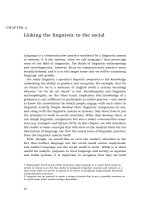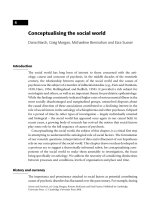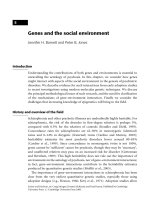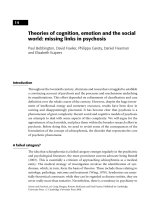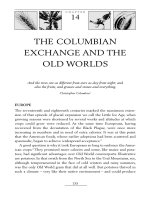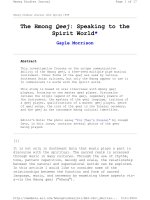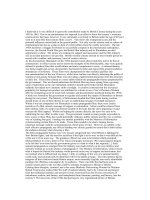Conceptualising the social world
Bạn đang xem bản rút gọn của tài liệu. Xem và tải ngay bản đầy đủ của tài liệu tại đây (282.84 KB, 17 trang )
4
Conceptualising the social world
Dana March, Craig Morgan, Michaeline Bresnahan and Ezra Susser
Introduction
The social world has long been of interest to those concerned with the aeti-
ology, course and outcome of psychosis. In the middle decades of the twentieth
century, the relationship between aspects of the social world and the causes of
psychosis was the subject of a number of influential studies (e.g., Faris and Dunham,
1939; Hare, 1956; Hollingshead and Redlich, 1958). It provided a rich subject for
sociologists and others, as well as an important theme for psychiatric epidemiology.
While the findings consistently indicated higher rates of serious mental illness in the
most socially disadvantaged and marginalised groups, unresolved disputes about
the causal direction of these associations contributed to a declining interest in the
role of social factors in the aetiology of schizophrenia and other psychoses. Eclipsed
for a period of time by other types of investigation – largely individually oriented
and biological – the social world has appeared once again in our causal field. In
recent years, a growing body of research has revived the notion that social factors
play some role in the full sequence of causes of psychosis.
Conceptualising the social world, the subject of this chapter, is a critical first step
in attempting to understand the aetiological role of social factors. The formulation
of our research questions, interpretation of data and refinement of our hypotheses
rely on our conception of the social world. This chapter draws on ideas developed in
a previous era to suggest a theoretically informed rubric for conceptualising com-
ponents of the social world to make them amenable to investigation, the focus
being specifically on aetiology. We address the necessity of considering distinctions
between processes and conditions, levels of organisation and place and time.
History and currency
The importance and prominence attached to social factors as potential contributing
causes of psychotic disorders has fluctuated over the past century. For example, during
Society and Psychosis, ed. Craig Morgan, Kwame McKenzie and Paul Fearon. Published by Cambridge
University Press. # Cambridge University Press 2008.
the latter half of the nineteenth and the first half of the twentieth centuries, the causes
of mental disorders were thought by some to be largely sociocultural in nature, a
perspective that perhaps reflected a wider concern with the socially corrosive effects of
large-scale processes – primarily industrialisation, urbanisation and migration. A
number of studies from this era found striking differences between social groups
and across social contexts in the prevalence of schizophrenia and other psychoses (for a
review of select domains, see Murphy, 1961). Totesttheoriesthatsocialarrangements
might be of aetiological significance, sociologists and social psychiatrists attempted to
capture and study markers of these dynamic social processes. Various constructs, such
as social disorganisation and social isolation, crystallised from sociological theories and
informed the construction of social variables that were examined quantitatively.
Perhaps the best known of these early studies is Faris and Dunham’s Mental
Disorders in Urban Areas (1939), a pioneering investigation carried out in Chicago
in the 1930s. The study examined the relationship between the functional psychoses
and social organisation, a construct that emerged from theories put forward to under-
stand the relationship between urban environs and social problems. Congruent with
the Chicago school of sociology, a dominant force in shaping the zeitgeist of socio-
logical research at the time, Faris and Dunham theorised social isolation and compro-
mised communication as sociological explanations of mental disorders. Application of
the concentric zone model of urban organisation – developed a decade earlier by their
mentor, sociologist Ernest Burgess, in a study of Chicago (Park et al., 1925) – allowed
Faris and Dunham to test their theories empirically. In this model, inner urban zones
consisted of the most disorganised communities, characterised by isolation and poor
communication among their residents. Social organisation increased as the circles
radiated from the epicentre (see Figure 4.1). Faris and Dunham hypothesised an
inverse relationship between social organisation and rates of mental disorder, i.e.,
that inner urban zones would have higher rates of mental disorder.
Mining available data to test this hypothesis empirically, Faris and Dunham
conceived of social organisation as a function of social interaction within a given
context, and examined variables that characterised communities in such terms.
Context was captured by characteristics of a community’s built environment as
measured by residence type (e.g., rooming-house, rental, etc.). Social interaction
was approximated by variables comprising population characteristics, both fixed
(e.g., country of birth) and dynamic (e.g., mobility and government assistance
status), framed in terms of the community (e.g., percent minority). Consistent
with their hypothesis, a distinct social patterning of schizophrenia – though not
manic-depression – emerged; the highest rates of schizophrenia were found in the
most socially disorganised areas.
As many commentators have subsequently pointed out, these findings do not
necessarily implicate social disorganisation in the aetiology of schizophrenia. They
42 D. March, C. Morgan, M. Bresnahan and E. Susser
may also reflect a downward drift of those with schizophrenia into areas charac-
terised by disorganisation and instability. Faris and Dunham considered down-
ward drift as one of a number of potential explanations of their findings, but
concluded that drift could not fully account for their results. In fact, their analysis
encompassed a whole range of social phenomena – including the notion of ethnic
density, explored in greater detail below. For our purposes, one of the most salient
aspects of the work of Faris and Dunham, which helped lay the foundation for
psychiatric epidemiology and shape quantitative sociological investigations with
the refinement of the ecological study design, is their sophisticated attempt to
conceptualise and measure aspects of the social environment.
In terms of conceptualising the social world, the work of Faris and Dunham
highlights two critical points still relevant to the study of social factors. First,
theory should inform constructs, which in turn, bear on our definition and
S
e
c
o
n
d
i
m
m
i
g
r
a
n
t
s
e
t
t
l
e
m
e
n
t
L
i
t
t
l
e
S
i
c
i
l
y
U
n
d
e
r
W
o
r
l
d
R
O
O
M
E
R
S
Restricted
r
e
s
i
d
e
n
t
i
a
l
d
i
s
t
r
i
c
t
B
u
n
g
a
l
o
w
s
e
c
t
i
o
n
S
i
n
g
l
e
f
a
m
i
l
y
d
w
e
l
l
i
n
g
s
A
p
a
r
t
m
e
n
t
h
o
u
s
e
s
B
r
i
g
h
t
l
i
g
h
t
a
r
e
a
II
Zone
in
transition
III
Zone
of
working men’s
homes
IV
Residential
zone
V
Commute
r
zone
Bright light area
Two flat area
Chinatown
Ghetto
Deutschland
I
Loop
Black belt
R
e
s
i
d
e
n
t
i
a
l
h
o
t
e
l
s
S
l
u
m
Residential hotels
Figure 4.1 The concentric zone model devised by Ernest Burgess in a 1920s study of Chicago (adapted
from Faris and Dunham, 1939)
43 Conceptualising the social world
measurement of variables. Second, to achieve an understanding of the full range
and sequence of causes of illness, social factors should be considered in concert
with other variables. When Faris and Dunham carried out their work in Chicago,
causal factors were viewed as being located in three primary domains: constitu-
tional, psychological and sociological.
The ecological notion of aetiology held by Faris and Dunham and their con-
temporaries eventually gave way to a focus on what they termed constitutional
factors. In the past 25 years, the primary focus in mainstream epidemiology and
medicine has been on biological and genetic determinants of health. Social factors
have often been relegated to the realm of the invariant and potentially confound-
ing; downstream causes, more proximal to the individual, have been prioritised.
In the current era, in which interest in social factors has been revived, we are
charged with understanding what and how social conditions and experiences over
the life course may contribute to the aetiology of psychosis (see Part II). In this,
there is much that can be learned from the early literature. The concepts put
forward by researchers in that era, like Faris and Dunham, inform a key guiding
principle: conceptualising the social world should be infused with theory and
attentive to history. Beyond the theory, we are also challenged to define and
measure constructs of interest. Below, we outline a logic and strategy – informed
by an ecological perspective – that can be used to build an understanding, and
capture the complexities, of the social world.
Processes and conditions
Organisation of the social world calls for consideration of the relationship between
processes and conditions. Processes refer to phenomena marked by changes that
lead to a particular result. Conditions are characteristics that evidence changes in
our world; they are indices of processes. At any given moment, they capture a state
resulting from processes. Conditions can be caused by one or more processes. Any
condition resulting from processes can be defined operationally and measured, at
least in theory. While this chapter focuses on social processes resulting in con-
ditions that may be considered aetiologically important exposures, it is important
to bear in mind that social processes are embodied and give rise to changes in states
of health. It is through the process of embodiment that social processes and
conditions play a causative role.
A number of steps are required. First, we need to form theories about the
aetiological role of processes and conditions and how they are embodied. We
then need to capture conditions quantitatively by forming constructs and variables
intended to measure these relevant operationally defined constructs. These steps
are dependent and inter-related. Formulating our hypotheses and empirically
44 D. March, C. Morgan, M. Bresnahan and E. Susser
testing our theories relies on our constructs and variables, and forming our
constructs and variables depends on our theories and hypotheses.
Consider, for example, socioeconomic status (SES), a common exposure and
confounder in psychiatric epidemiology. Socioeconomic status is a complex con-
dition that results from many dynamic processes. However, most studies treat SES
crudely as a unidimensional and static condition. The conception of SES varies by
location; in Europe, occupation forms the basis for SES, while income or educa-
tion is used in the USA (Braveman et al., 2005). Moreover, the point at which SES
is measured is a crucial consideration; changes in SES over the life course affect risk
of various outcomes – a finding well documented for physical health outcomes
(e.g., Davey Smith et al., 1997). Various indicators of SES capture different aspects
of the construct, and thus have limitations in terms of measuring SES as a social
cause of illness (Galobardes et al., 2006). Many measures of SES lack the proper
grounding in social theory, which, in effect, divorces SES as a condition from the
processes that gave rise to it.
We can take this further. Wittingly or not, the choice of occupation or education
as a marker for SES will reflect past theoretical formulations. Concern with social
status and position within the overall social structure has been a focus of sociological
interest for the past century. Many of the most influential thinkers produced detailed
theories relevant to understanding social structure and its influence on action. For
instance, Marx’s formulation of social class as a function of an individual’s relation-
ship to the means of production underpins the use of occupation (i.e., economic
position) as the basis for determining SES – even if current systems of classification
include more social classes than a Marxist theoretical orientation permits. In con-
trast, the use of education, income and wealth as markers of SES reflects Weberian
notions that social position is influenced partly by ‘social honour’ and ‘styles of
living’ in specific communities. Understanding that social factors, like those cap-
tured by SES, affect health is well established (e.g., Marmot and Wilkinson, 1999).
Understanding how, which requires theory, is our current challenge (Lynch and
Kaplan, 2000). Ultimately, our choice of theory, which shapes our constructs and
our variables, must be guided by a broad conception of aetiology, encouraging us to
consider the mechanistic role of social factors.
Indeed, the role of social factors was examined rigorously within the context of
the selection–causation debate (e.g., Dohrenwend et al., 1992). A clear social class
gradient exists for schizophrenia; those with the disorder are much more likely to
be of low SES. Preoccupation with whether SES is a cause or consequence of the
disorder has ultimately led to a focus on parental – primarily paternal – social class
at birth. With parental social class, however, the evidence for a gradient is incon-
sistent; it appears that SES affects the risk of schizophrenia in children only from
the lowest social classes or with other indicators of adversity (Byrne et al., 2004;
45 Conceptualising the social world
Wicks et al., 2005). The point is that an emphasis on the role of SES diverted
attention from conceptualising and investigating other aspects of the social world.
Creative efforts to translate concepts of social stratification into environmental
exposures have not been taken up in larger contexts (Link et al., 1986). Overall,
theoretical considerations have been generally absent from debates in the recent
literature about the relationship between SES and psychosis.
Recognition of these and other problems has led to recent calls for a refined
approach to SES that is both outcome and social group specific. Braveman and
colleagues (2005) recommend granting consideration to: plausible pathways and
mechanisms, gathering all potentially relevant socioeconomic information, speci-
fying the measured components of SES and systematically considering the poten-
tial effects of unmeasured socioeconomic factors. An important step forward is the
recognition that most of our current measures capture a condition at a given
moment. As the product of complex processes, a condition is subject to change
over time. The challenge is to develop concepts and methodological tools that are
better equipped to approximate social processes and their dynamics over time.
Levels of organisation
There are myriad ways in which the social world and related processes have been
understood and studied in relation to health and illness by researchers working
from within a range of academic disciplines. The scope of this chapter limits
consideration of that work. Our focus is instead on the provision of a framework,
with illustrative examples, built on the idea that the social world can be concep-
tualised and studied at different levels of organisation, from the microscopic to the
macroscopic.
In our world, phenomena take on different properties as they become increas-
ingly complex. There are different levels at which certain properties of phenomena
emerge; they constitute the units of analysis in our research studies. While the
concept of levels of organisation is not new – it was formally introduced into
epidemiology by Mervyn Susser in the 1970s (Susser, 1973) – it was taken up in the
mainstream only in the last decade (Diez-Roux, 1998). It forms a useful organising
framework for this discussion.
Central to this framework is the notion that phenomena can be arranged in a
hierarchy of increasing complexity. Each level of organisation is a more complex
whole consisting of less complex parts. Each whole is one level of organisation
higher than its component parts, and creates the context in which its component
parts exist. A part on one level of organisation is a whole on a lower level of
organisation, and a whole on one level of organisation is a part on a higher level of
organisation (March and Susser, in press; Susser et al., 2006, pp. 441–60). For
46 D. March, C. Morgan, M. Bresnahan and E. Susser

